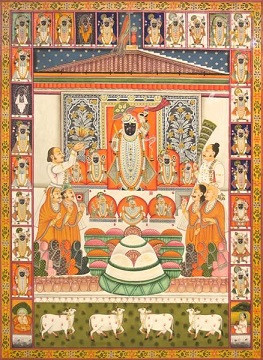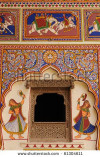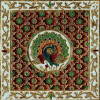Nathadwara painting is a style of painting which has originated from the Nathadwara town in Rajsamand district, Rajasthan. This painting is associated with the religious beliefs and traditions of Vallabha Sampradaya of the followers of Vaishnavism and Pushti Marg. This art form has different sub-styles like Pichhvai painting, Haveli painting, etc. This art form is mostly associated with the cloth or textile painting or wall hangings of Srinathji and his various forms and incarnations.
History and Origin of the Art
The primary cause of the development of Nathadwara painting style was to protect the Hindu religious practices of worshipping from the oppressions of the Mughal emperor Aurangazeb, who had destroyed many temples and idols of Gods and Goddesses. As a part of this programme, an image of Srinathji, a child manifestation of Sri Krishna, was installed in the Nathadwara city in 1670 by the Goswami priests from Mathura. This act began the development of the painting of Srinathji in a particular style known as the Nathadwara style. This style is considered to be a subset of the Mewar school of painting.
Themes, Purpose, and Sub-styles of the Art
The main theme of the art is to portray various forms, incarnations, and tales of Srinathji on a canvas. Almost all the paintings revolve around the portrayal of Srinathji in different postures, moods, and depictions of various tales about his life. Therefore, other than worshipping, these paintings were also once used for narrating life and preaching the divinity of Srinathji to the illiterate. The most popular depiction on the canvas is the image of Srinathji holding the Govardhan Hill on the little finger of his left hand and his right hand resting on his waist. The other themes are Srinathji surrounded by gopis (milkmaids), Srinathji with Mata Yashoda, Bal Gopal, and Nandlal.
Nathadwara painting has different sub-styles. The most important sub-styles are Pichhwai painting and Haveli painting
Pichhawi Painting - The word Pichhwai is derived from the Sanskrit words Pich which means the back and Wais means hanging. Pichhwai paintings are cloth paintings that are hung behind the shrine of Srinathji. Pichhwai painting has a devotional aspect and is used to narrate the tales of Srinathji’s life to the common people. Pichhwai painting is a group effort where many skilled artists work under a master artist to produce a Pichhwai painting.
Haveli Painting - In Nathadwara, Srinathji is considered to be a living deity. So, the place or building where Srinathji resides in Nathadwara is known as a Haveli. Unlike temples, the architecture of the Havelis resembles that of palaces or mansions with various rooms which are linked by verandas, passages, and courtyards. The entry walls and doorways of these Havelis are decorated with beautiful paintings of elephants with their mahouts (riders), tigers, peacocks, female figures wearing pieces of jewellery, etc. These paintings are known as Haveli paintings. It is believed that the haveli painting traditions emerged in the 19th century.
Painting Techniques
The paintings of Nathadwara were originally painted on handspun cotton fabrics. The painters used to sketch the outline of the images at first on the starched cloth then colour them with natural colours and handmade brushes. The organic colours were obtained from coal, indigo, gold, silver,saffron, zinc, and other such natural sources. The dominating colours are bright colours like red, black, green and yellow. The ornate part used to be coloured with pure gold and the borders were decorated with decorative elements like crystals.
The highlight of a Nathadwara painting is that it has 24 boxes known as Swaroops containing images of Gopis, Krishna, etc to make the image of Srinathji elaborate and captivating. The image of Srinathji is drawn using important details like a big nose, large eyes, and fat belly. Using these distinct features in the painting enhances the expressions of the deity and radiates divine feelings.
Present Scenario of Nathadwara Painting
In the beginning, the making of an intricate Nathadwara (Pichhwai or Haveli) took months to finish. It was built on huge cloth canvases, using organic dyes, and was only used for devotional purposes. With time this way of painting became very time-consuming and expensive and hence lost its importance. But as we are incomplete without our culture and heritage, modern artists and art lovers are regaining their interest in this age-old art form. They have also put effort to modernize art according to the want of the present times. Cloth canvas has been replaced with paper, the size has been reduced and colours used are now either synthetic or a mixture of natural and synthetic dyes. Its use is also no longer confined to devotional purposes and is made into beautiful wall hanging and room decorations with images of flora, fauna, and scenes from the civil lives of Rajasthan. They are sold to common people and art lovers from home and abroad through fairs, exhibitions, and online modes. Various online platforms are associated with buying and selling of Nathadwara art and crafts. ARTSofINDIA.in is such an online platform that facilitates the easy purchase of Nathadwara paintings directly from the artists.
Important Nathadwara Painters
Shan Bhatnagar is a notable artist of Nathadwara style who has self-taught himself about this art form and now has even innovated this art form according to his likes. A Baroda-based artist and art historian, Sandeep Joshi has made efforts to reestablish this age-old painting style among the masses through his blogs on Nathadwara painting. With the cumulative efforts of artists and government and private organizations, Nathadwara painting is hoping to emerge afresh from the sands of time.
Picture Source: Pinterest



